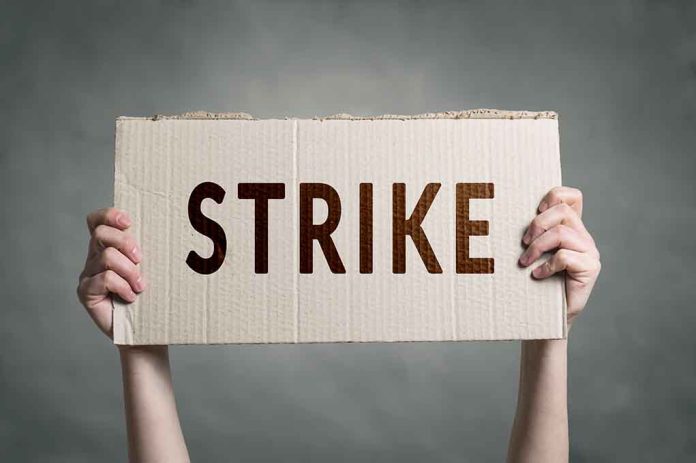
A potential dockworkers’ strike threatens to cripple U.S. East and Gulf Coast ports, with dire economic consequences looming on the horizon.
At a Glance
- About 45,000 dockworkers threaten to strike on Oct. 1, shutting down ports handling half the nation’s cargo
- The International Longshoremen’s Association demands higher wages and a ban on automation
- A strike could result in a daily economic loss of $3.7 billion
- The union and the United States Maritime Alliance haven’t negotiated since June
- President Biden is not expected to intervene before the Nov. 5 presidential election
Looming Economic Crisis as Dockworkers Threaten Strike
The United States faces a potential economic catastrophe as approximately 45,000 dockworkers along the East and Gulf Coasts prepare to strike on October 1. This labor dispute threatens to paralyze ports responsible for handling about half of the nation’s cargo from ships, potentially costing the economy a staggering $3.7 billion per day.
The International Longshoremen’s Association (ILA), representing these workers, is pushing for higher wages and a ban on automation, setting the stage for a contentious battle that could ripple through the entire U.S. economy.
Eric Hoplin, CEO of the National Association of Wholesaler-Distributors, warns that Americans will “feel the pinch” of this strike “every single day.” The timing couldn’t be worse, with the holiday season approaching and retailers already struggling with supply chain issues. This impending crisis highlights the vulnerability of our nation’s infrastructure and the outsized influence of labor unions on our economic stability.
Port strikes could be 'devastating' to economy, trade group warnshttps://t.co/NfmosVOaGh
— FOX Business (@FoxBusiness) September 19, 2024
Union Demands and Negotiation Deadlock
The ILA’s demands are nothing short of outrageous. Initially, they sought a 77% pay raise over six years, a figure that would undoubtedly drive up costs for businesses and consumers alike. Moreover, their insistence on banning automation flies in the face of progress and efficiency.
Top-scale port workers already earn a base pay of $39 an hour, with some making over $200,000 annually with overtime. These exorbitant wages, coupled with resistance to technological advancement, threaten to make U.S. ports less competitive on the global stage.
This hardline stance has led to a breakdown in negotiations. The union and the United States Maritime Alliance haven’t met for talks since June, with the ILA halting discussions in July over alleged contract violations related to port automation. The Maritime Alliance’s attempts to resume talks and their offer to maintain provisions barring fully automated terminals have fallen on deaf ears.
Economic Impact and Political Implications
The potential economic fallout from this strike cannot be overstated. A shutdown of ports for just three to five days could result in a $3.7 billion daily economic loss. This disruption would affect not only the shipping industry but also ripple through the entire supply chain, potentially leading to shortages of consumer goods and further fueling inflation.
Adding to the complexity of the situation is the looming presidential election. President Biden, known for his pro-union stance, is not expected to intervene before November 5. This political calculation leaves the economy vulnerable to the whims of union leaders who seem more interested in flexing their muscle than in finding a reasonable solution.
The Taft-Hartley Act, which allows for an 80-day cooling-off period if a strike endangers national health or safety, remains an option. However, the administration’s reluctance to use this tool underscores the influence of labor unions in current political discourse.
As the October 1 deadline approaches, businesses and consumers alike must brace for potential economic turbulence. The intransigence of union leadership and the political considerations surrounding this dispute highlight the need for a more balanced approach to labor relations in critical infrastructure sectors. The coming weeks will reveal whether cooler heads will prevail or if the nation will be forced to weather yet another self-inflicted economic crisis.






















